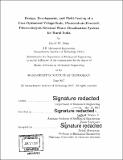| dc.contributor.advisor | Amos G. Winter, V. | en_US |
| dc.contributor.author | Bian, David W | en_US |
| dc.contributor.other | Massachusetts Institute of Technology. Department of Mechanical Engineering. | en_US |
| dc.coverage.spatial | a-ii--- | en_US |
| dc.date.accessioned | 2017-10-04T15:07:57Z | |
| dc.date.available | 2017-10-04T15:07:57Z | |
| dc.date.copyright | 2017 | en_US |
| dc.date.issued | 2017 | en_US |
| dc.identifier.uri | http://hdl.handle.net/1721.1/111773 | |
| dc.description | Thesis: S.M., Massachusetts Institute of Technology, Department of Mechanical Engineering, 2017. | en_US |
| dc.description | Cataloged from PDF version of thesis. | en_US |
| dc.description | Includes bibliographical references (pages 85-91). | en_US |
| dc.description.abstract | The aim of this research was to identify the effectiveness of cost-optimizing a photovoltaic-powered electrodialysis reversal (PV-EDR) system for village-scale applications in rural India based on current component costs and performance. Currently available village-scale off-grid desalination systems have high capital costs - $11,250 USD compared to $4,500 USD for equivalent grid-connected systems - rendering them prohibitively expensive for cost-constrained communities. Compared to current state-of- the-art PV-powered reverse osmosis desalination systems, electrodialysis has the potential to reduce capital cost due to the lower energy requirement of the ED process at brackish feed water salinities. The parametric relationships that govern the characteristics of the electrodialysis process and photovoltaic power systems were investigated and a model was created to predict a PV-EDR system's cost and performance. Through optimization, it was found that the optimal design was composed of a GE Water electrodialysis stack with 62 cell pairs, an applied stack voltage of 45 V, a batch size of 0.42 in 3 , and a power system with 57.5 m2 of photovoltaic solar panels and 22 kWh of batteries. The system is predicted to run 17.7 hours per day on average and cost $23,420. This was a 42% reduction from the $40,138 cost of a PV-EDR system designed using the conventional engineering practice of sequentially designing the load and then the power system. A sensitivity analysis was conducted to evaluate the effects of different parameter changes on optimal system cost and design. The analysis revealed that relaxing the reliability requirement from 100% to 98% would reduce the optimal cost by 5.7%. An ED membrane cost reduction of 87% would cause the previous optimal system design to have a system cost of $15,360. The analysis revealed that optimizing the system with the lower membrane cost results in a system with a different configuration and a system cost of $11,717, a 24% additional cost reduction that was enabled by a flexible operation schedule since the lower membrane cost optimized system would operate on average for 8.6 hours per day instead of 17.7. A pilot PV-EDR system was built and installed in the village of Chelluru in India, where a week-long trial was conducted to collect initial data and results. With the exception of a few practicalities not considered in the model, the experimental results closely matched the PV-EDR system performance model on the basis of solar irradiance, batch power and battery energy levels. To fully validate the model and make it more accurate, long-term field testing must be conducted over the course of a full annual irradiance cycle. | en_US |
| dc.description.statementofresponsibility | by David W. Bian. | en_US |
| dc.format.extent | 91 pages | en_US |
| dc.language.iso | eng | en_US |
| dc.publisher | Massachusetts Institute of Technology | en_US |
| dc.rights | MIT theses are protected by copyright. They may be viewed, downloaded, or printed from this source but further reproduction or distribution in any format is prohibited without written permission. | en_US |
| dc.rights.uri | http://dspace.mit.edu/handle/1721.1/7582 | en_US |
| dc.subject | Mechanical Engineering. | en_US |
| dc.title | Design, development, and field-testing of a cost-optimized village-scale, photovoltaic-powered, electrodialysis reversal water desalination system for rural India | en_US |
| dc.type | Thesis | en_US |
| dc.description.degree | S.M. | en_US |
| dc.contributor.department | Massachusetts Institute of Technology. Department of Mechanical Engineering | |
| dc.identifier.oclc | 1004864806 | en_US |
